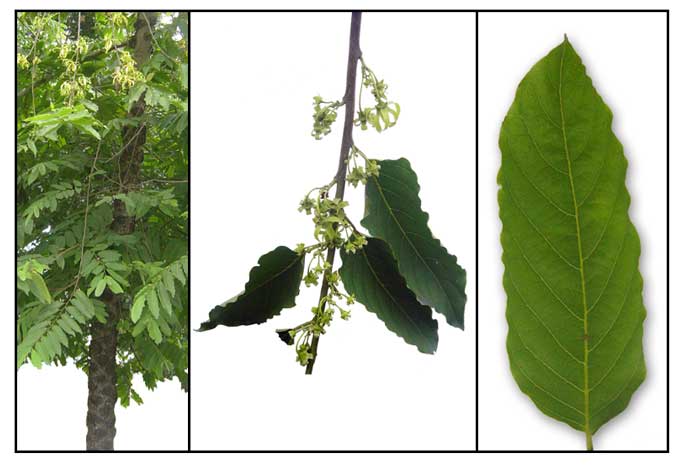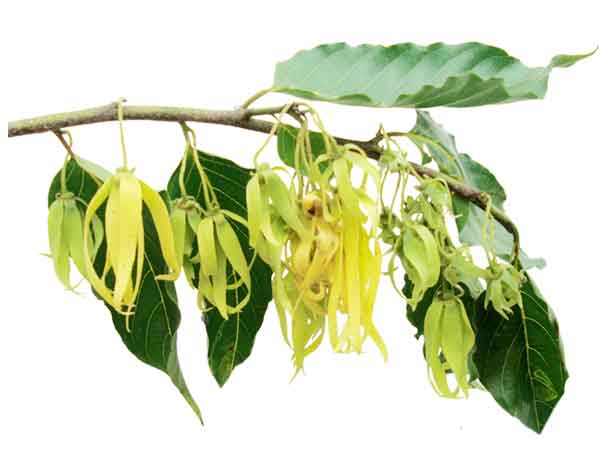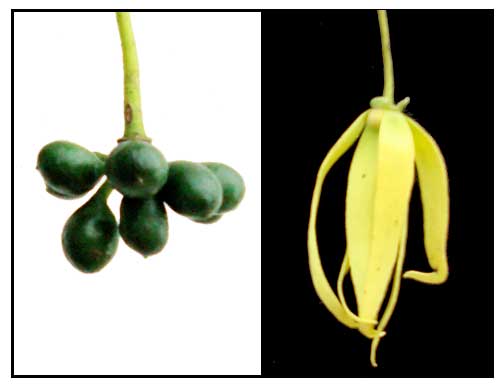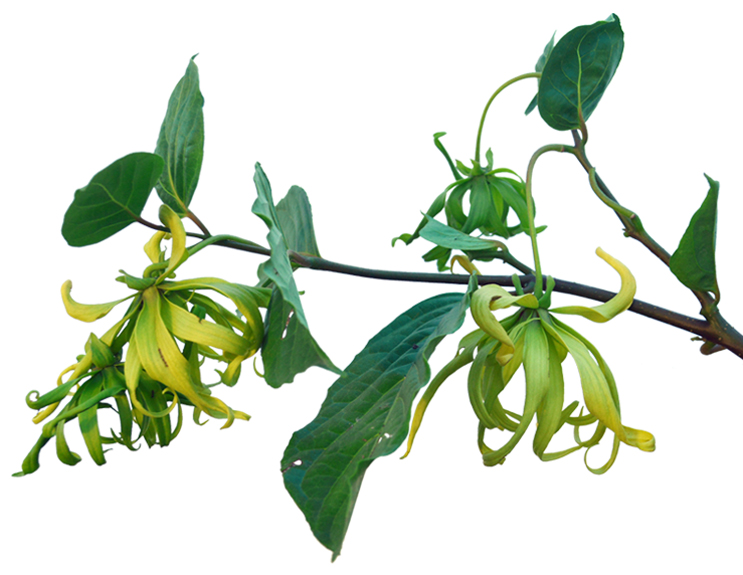|
 General info General info
- Cananga is a small genus of trees in the family Annonaceae. Two species are recognized: Cananga brandisiana (Pierre) Saff., and Cananga odorata (Lam.) Hook.f. & Thomson. (42)
-
A variety, Cananga odorata macrophylla (Cannagium odoratum macrophylla)
yields Cananga oil, also used in the manufacture of cosmetics and soap,
flavoring of foods as gelatins and puddings.
- Ylang-ylang is one of the most extensively used natural material in the perfume industry, earning it the name "Queen of Perfumes".
- Etymology: Ylang-ylang is the Spanish spelling of its Tagalog name, ilang-ilang, a reduplicative form of the word "ilang", meaning "wilderness", alluding to the tree's natural habitat. A common mistranslation is "flower of flowers".
- Commerce: In the late 1980s, world production of ylang-ylang oil was about US$7M, compared to US$1.35M for cananga oil.
- Ylang-ylang oil is fractionated in different grades. In Madagascar 4 grades are recognized: Extra, First, Second, and Third. Another grade, Premier, is only produced by special order. Extra and First are used in fine perfumery, Second and Third are used in soap perfumery. (41)
- Ylang-ylang oil "Extra" is the first and most volatile fraction containing 20-40% of total distillate. Ylang-ylang oil blends well with bois de rose oil, methyl salicylate, phenylethyl cinnamate and vetiver oil. It is used as modifier in artificial violet and lilac perfumery products. (41)
- Adulterants: Flowers of climbing ylang-ylang (Artabotrys uncinatus) are sometimes mixed with true ylang-ylang flowers as adulterants. They resemble true C. odorata flowers and are also fragrant.
(41)
 Botany Botany
Ilang-ilang is a medium-sized tree growing 10 to 30
meters in height, with pendulous branches, with drooping, leafy twigs. Flowers
are fragrant, axillary, in umbellate hanging clusters, with three sepals
and six petals, twisted when young and drooping when mature. Leaves
are dark green, up to 20 centimeters in length, alternate, simple, entire. Fruit
is black in color, 1.5 to 2 centimeters in length, in axillary clusters, fleshy
and olive-like, with six to 12 seeds in each fruit.
Distribution
- Native to the Philippines.
-
Cultivated for ornamental
purposes.
- Also native to Borneo, Jawa, Lesser Sunda Is., Malaya, New Guinea, Queensland, Solomon Is., Sulawesi, Sumatera, Thailand, Vietnam. (18)
Constituents
• The oil extracted from fresh flowers has a floral fragrance.
• The oil is distilled from freshly harvested flowers.
• Study of fruits isolated a new guaipyridine sesquiterpene alkaloid, cananodine (1), and two new eudesmane sesquiterpenes cryptomeridiol 11-alpha-L-rhamnoside (2) and gamma-eudesmol 11-alpha-L-rhamnoside (3), along with gamma-eudesmol (4). Compounds 1-4 and four previously reported alkaloids, cleistopholine (5), N-trans-feruloyltyramine (6) (+)-ushinsunine-beta-N-oxide (7), and lyscamine (8) were evaluated for cytotoxicity. (see study below)
(1)
• Fractionation of essential oil isolated 17 compounds. From the
volatile, oxygenated and hydrocarbon fractions, 52 compounds were identified,
among them: (alpha)-cedrene, (alpha)-amorphene, (gamma)-gisabolene and
cadinols. (5)
• From the leaves and branches, two unusual lactones were isolated:
one already known, isosiphonodin; and the other, canangone, a new terpenoid
spirolactone. (6)
• Study of stem bark extract reported liriodenine, anonaine, roemerine, ushinine, and canangine, which was later reported as eupolauridine. (see study below) (14)
• Phytochemical study of leaves yielded four compounds, viz., two steroids: ß-sitosterol and stigmasterol, and two oxoaporphine alkaloids: liriodenine and lysicamine. (15)
• Study of essential oil of leaves yielded a total of 23 components. The principal compounds were linalool (21.08%), linalool acetate (16.14%) α-pinene (12.73%), eugenol (8.86%), and α-terpineol acetate (7.71%), with isobornyl acetate (3.56%), c-terpineol (3.46%) and camphor (3.23%). (see study below) (16)
• Phytochemical analysis of various leaf extracts yielded alkaloids, carbohydrates, glycosides, saponins, phenols, tannins, flavonoids, proteins and amino acids, steroid, and coumarin. (23)
• Study for volatile compounds from flower essential oil yielded limonene, linalool, benzyl acetate and ß-caryophyllene, while leaf essential oils yielded α-pinene and ß-caryophyllene. (25)
• GC-MS analysis of fresh flower essential oil yielded
main constituents of α-humulene (7.1%), germacrene D (8.1%), (E,E)-α-farnesene (12.6%), (E,E)-farnesol (5.6% and benzyl benzoate (3.8%). Major constituents of the oil were linalool (8.7%) and ß-caryophyllene (26.8%). (30)
• GC-MS study for leaf essential oil identified a total of 25 components (91%). Major compounds were trans-caryophyllene (19.7%), ocimene (13.2%), E, E-α-farnesene (10.3%), phenylmethyl ester (5.6%), farnesyl acetone (5.1%), t-muurolol (4.2%), farnesol (3.7%), ß-elemene (3.1%), α-cadinol (3.0%), copaene (2.9%) benzyl-benzoate (2.3%), trans-farnesol (2.1%). The EO is rich in sesquiterpenoids including sesquiterpenes hydrocarbon (42.3%), monoterpene hydrocarbons (18.1%) and oxygenated compound (30.7%).
Properties
• Essential oil considered antidepressant, antiseborrheic, antiseptic, aphrodisiac, nervine and sedative.
• Studies have suggested antioxidant, antimicrobial, antibiofilm, anti-inflammatory, antivector, antidiabetic, antimelanogenesis, cytotoxic, antifertility, insecticidal properties.
Parts
used
Flowers, bark, oil.
 Uses Uses
Edibility
- Oil used as flavoring agent for beverages, ice cream, candies
and baked goods.
Folkloric
- Oil Used for a variety
of infectious and skin diseases, acne and scalp conditions.
- Sedative and antidepressant.
- Reduces sebum in oily skin.
- Use for insect bite.
- Bark decoction used for rheumatism, ophthalmia, ulcers and fevers.
- In Java and Vietnam, dried flowers used to treat malaria.
- In Indonesia, oil used to enhance euphoria during sex and to reduce sexual anxiety.
- Reportedly used to decrease blood pressure.
- In India, used topically to relieve itching and also to treat dandruff.
- In Tonga and Samoa, bark used to treat stomach ailments and as a laxative.
- In Papua New Guinea, bark decoction used to treat gout.
- In Tonga and Samoa, bark decoction used as laxative.
- In Java, flowers used for malaria, and fresh flowers, pounded into a paste, used for asthma.
Others
• Perfumery: Primary commercial product is the oil distilled for the perfume industry. Oil is used as
a fragrance for cosmetics (1% in perfumes), soaps, shampoos, creams
and lotions. (•) Cananga oil mixed with coconut oil is used as hair oil, Macassar oil, different from the seed oil from Scheiichera oleosa, which is similarly called. Thai women apply an infusion of flowers on the body after bathing.
• Aromatherapy: Essential oil used in aromatherapy, with claims of usefulness for depression, breathing problems, hypertension, and anxiety.
• Matrimonial: Also
regarded as an aphrodisiac. In some Asian countries, the flowers are
laid out in matrimonial beds.
• Motion sickness: An ingredient
in motion sickness medicine, MotionEaze.
• Ornamental: Fragrant flowers used in making lei and headdresses.
• Wood: Wood is used in making small canoe parts, furniture, fuel wood and cordage. (11) Used for making small drums and matchsticks.
• Fiber: In Indonesia, ropes made out of beaten bark. (20)

Studies
• Cytotoxic
/ Anticancer / Fruits: A new guaipyridine sesquiterpene alkaloid, cananodine, and two new eudesmane
sesquiterpenes were isolated from the fruits of CO and were evaluated
for cytotoxicity against two human hepatocarcinoma cell lines. (1)
• Antibacterial and cytotoxic / Bark: Isolated compounds
from the bark showed antibacterial activities, as well as antifungal
and cytotoxic activities. (2)
• Relaxing Effect / Aromatherapy: Using human physiological parameters and self-evaluation after transdermal absorption In a study of 40 healthy volunteers, ylang ylang oil caused a significant decrease of blood pressure and increase of skin temperature with subjective ratings of being calmer and more relax than in the control group. Study suggests some evidence of usage of the ylang ylang oil in aromatherapy for relief of depression and stress in humans. (4)
• Antifertility: The study of ethanol
extract of Cananga odorata possesses antifertility effects with statistically
significant alterations in sperm morphology as well as activity of HMG
CoA reductase and G6PD activities and serum testosterone. (7)
• Spermatotoxic / Root Bark: Study of 50% ethanolic extract of root bark of C odorata resulted in spermatotoxic effects, i.e., decreased epididymal sperm motility and sperm count in male albino rats. (8)
• Antimicrobial / Leaves: Study evaluated the antimicrobial effect of various leaf extracts of Cananga odorata on bacterial cultures including Staphylococcus aureus, Salmonella typhi, E coli, Vibrio cholerae and fungus Epidermophyton floccosum., M. gypseum, and T. mentagrophytes. Among extracts tested, methanol was more effective than chloroform and petroleum ether. (12)
• Effects of Aroma on Blood Pressure and Heart Rate in Healthy Men: Study showed YYA (ylang-ylang aroma) caused a reduction of HR and BP, and a relief of the arousal level in healthy men. Results suggest a sedative effect of YYA, and provides evidence of usage as a medicinal agent. (13)
• Sampangine / Alkaloid / Leaves: Study of stem bark extract by Cave and co-workers reported liriodenine, anonaine, roemerine, ushinine, and canangine, which was later reported as eupolauridine. This study of a chloroform extract reports the isolation of two alkaloids, A (new and named sampangine) and B. (14)
• Insecticidal / Essential Oil: Study evaluated the chemical composition and insecticidal activity of the essential oil of C. odorata leaves against maize weevils (Sitophilus zeamais). The essential oil showed strong contact toxicity against S. zeamais. The essential oil also showed fumigant toxicity against the grain storage insect. (see constituents above) (16)
• Volatile Organic Compound Emissions from Stages of Flower Development: Study evaluated the volatile organic compounds (VOCs) of the different flower development stages of Cananga odorata for the evaluation of floral volatile polymorphism as a basis to determine the best time of harvest. Ninety-two compounds were identified over the flower life. The VOCs were largely hydrocarbons, esters, alcohols, aldehydes, phenols, acids, ketones and ethers. The main compound was ß-caryophyllene; others were β-cubebene, D-germacrene, benzyl benzoate, and α-cubebene. (17) The chemical composition of oils extracted from flowers at different stages of development differed both qualitatively and quantitatively. Generation of total volatile metabolites increased markedly during flower maturation. (21)
• Essential Oil Constituents of Varieties at Different Flowering Stages: Study of three varieties of essential oils showed the odor quality was related to the variety, contents of esters, alcohols and phenolic ethers; and the greater the sesquiterpenes and sesquiterpenols, the worse the odor quality. The quality of the oil was also better when obtained from the flowers when the flower color changed from green to yellow than oil obtained from green flowers or flower buds. (22)
• Spermatotoxic Effects: Study of 50% ethanolic extract of root bark showed spermatotoxic effects in male albino rats. Results showed decreased epididymal sperm motility and sperm count, suppression of testosterone production and increase in its catabolism, with alteration in micronutrients of the testis causing deficiency in nutrients for the proper maturation and function of sperms. (24)
• Antioxidant / Antibacterial / Flower Essential Oil: Essential oil from C. odorata flower and leaf showed antioxidant activity, especially in inhibiting lipid peroxidation. Flower EO inhibited growth of bacterial strains tested, and flower and leaf EO showed antifungal activity against fungal strains tested. (25)
• Anti-Inflammatory: Study evaluated the anti-inflammatory activity of ethanolic extract of C. odorata using carrageenan-induced paw edema in Wistar albino rats. Results showed highly significant anti-inflammatory activity, higher than standard drug aspirin in the studied doses. (26)
• Aromatherapy / Pilot Study for Anxiety and Self-Esteem: Pilot study on 34 professionals from a nursing group evaluated the of ylang ylang essential oil by cutaneous application or inhalation for effects on anxiety and self-esteem perception and physiological parameters such as blood pressure and temperature. Results showed a significant difference in self-esteem; however, there were no differences in analysis for anxiety and physiological parameters. (27)
• Mosquito Insecticidal Potential / Essential Oil: Study of the essential oil of C. odorata flowers for oviposition-deterrent, ovicidal, insecticidal, and repellent activities against three mosquito species: Aedes aegypti, Anopheles dirus, and Culex quinquefasciatus showed potential for use as a botanical insecticide. (28)
• Analgesic: Insecticidal Potential / Essential Oil: Study of ethanolic extract of CO showed central and peripheral analgesic activity by Tail Flick method and Acetic Acid Induced Writhing tests in Swiss albino mice. (29)
• Effect of Picking Time on Essential Oil: Study evaluated the optimal harvesting time for ylang-ylang flowers to maximize essential oil yield. Results showed stages and sizes of flowers affected essential oil yield. Picking flowers at *:00 am in the morning highest yield. Main constituents of flower essential oil were as follows: geranyl acetate (18.28%), benzyl benzoate (14.42%), germacrene D (10.92%), trans-caryophyllene (10.71 %), geraniol (8.44%) and eugenol (6.65%). (31)
• Antimicrobial / Flowers: Study evaluated the antibiotic property of eight different selected flowers against various human bacterial pathogens. Extracts during blossoming time were found to be more effective. Cananga odorata flowers showed stronger antibacterial activity. (32)
• Vapor Aromatherapy in Chemotherapy-Induced Anxiety State among Breast Cancer Patients / Clinical Trial: A randomized controlled trial evaluated the short-term, immediate effect in reducing chemotherapy-induced anxiety state among 34 stage II and III female breast cancer patients. Results showed reduction of anxiety state among Stage II and III breast cancer patients undergoing chemotherapy who had moderate anxiety. (33)
• Anti-Hepatitis B Virus Activity / Flowers: Chronic hepatitis B virus (HBV) can lead to liver cirrhosis and hepatocellular carcinoma. Study screened various crude extracts of Indonesian plants for anti-HBV activity by determining effects on production of extracellular HBV DNA in Hep38.7-Tet cells and HBV entry into a HBV-susceptible cell line, HepG2-NTCP. In Hwp38.7 cells, Cananga odorata exhibited highest anti-HBV activity with IC50 of 56.5 µg/ml and CC50 of 5409.2 µg/ml (Selectivity index: 9.6). C. odorata showed lowered level of HBsAg production of 58.0% at 100 µg/ml concentration. Results suggest C. odorata extract has potential as candidate for development of anti-HBV drugs. (34)
• Anti-Inflammatory / Essential Oil: Study evaluated the acute toxicity and effect of ylang-ylang essential oil (YEO) on acute inflammation. Oral treatment with YEO reduced leukocyte recruitment and nitric oxide production in zymosa-induced peritonitis model, reduced rolling and adherent leukocyte number induced by carrageenan in the in situ microcirculation model, and reduced carrageenan-induced edema and mechanical hyperalgesia. The YEO showed a predominance of benzyl acetate, linalool, benzyl benzoate, and methyl benzoate. YEO did not show signs of toxicity in acute toxicity testing. Results suggest YEO affected leukocyte activation and exhibited antiedematogenic, anti-hyperalgesic, and anti-inflammatory properties. (36)
• Antioxidant / Anticancer Potential / Essential Oil of Leaves: Study evaluated C. odorata for leaf essential oil. The EO was tested for antioxidant efficiency by DPPH radical method with BHA as standard. The EO showed concentration-dependent antiradical activity with EC50 of 19,5±1.25 µg/mL with BHA showing an EC50 of 1.10 ± 0.55 µg/mL. In-vitro anticancer potential of EO by MTT assay using MOLT-3 cell line exhibited significant anticancer activity with IC50 of 44.22 µg/mL. Results showed the EO possesses significant antioxidant and anticancer properties with potential as a natural supplement as antioxidant and anticancer agents. (37)
• Solvent-Free Microwave Extraction of Essential Oil from Flowers: Extraction of EO by convention methods such as hydrodistillation, steam hydrodistillation and steam distillation takes a long time. Study reports on the extraction of cananga oil using solvent-free microwave extraction (SFME) method. GC-MS analysis of extracted oil showed main components of ß-caryophyllene (16.85%), benzyl benzoate (14.32%), caryophyllene oxide (13.48%) and germacrene (10.69%). The SFME method offers the possibility for better reproduction of the natural aroma of flower EO compared to that obtained by conventional method. (38)
• Anti-Biofilm Properties Against P. aeruginosa / Essential Oil: Study evaluated the anti-biofilm properties of C. odorata essential oil against Pseudomonas aeruginosa. Results showed significant inhibitory effects of C. odorata essential oil against biofilm formed by P. aeruginosa. The MBIC and MIC were shown to be at 50% concentration of C. odorata essential oil. (39)
• Repellent / Thixogel Formulation / Essential Oils of C. odorata and C. nardus: Study evaluated thixogel formulations based on corn starch containing the combination of essential oils from ylang-ylang (C. odorata) and citronella (Cymbopogon nardus) plants, its safety, and mosquito repellent activities. Organoleptic studies showed the formulations of thixogel without EO (F0), with ylang-ylang oils (F1), with citronella oils (F2), and with both EOs (F3). All the formulations had thixotropic properties without human skin irritation. The F2 formulation significantly improved repellent activity against Aedes aegypti compared to single EO on corn-starch based thixogel (F1 and F2). Results suggest potential for topical administration of EO as ecofriendly repellent agents, which are safe for humans, domestic animals. (40)
Safety / Allergy concerns
- Probably safe
in the amount found in foods.
- No known interactions with herbs and other dietary supplements
- In cosmetics, used in moderation, the oil is non-toxic and a non-irritant. However, the oil is considered as an allergen, and has been removed from some cosmetics. (10)
Availability
- Wild-crafted.
- Cultivated for ornamental use.
- Extracts and essentials oils in the cybermarket. |


![]()

